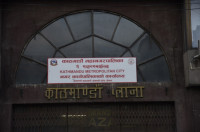Food
This Japanese noodle-maker is in Kathmandu to teach Nepalis how to make udon
In the shadow of the Boudhanath Stupa, Jon Tanimura contemplates a bowl of steaming thukpa and a plate piled high with spicy chowmein glistening with oil. The freshly-made noodles are somewhat familiar but he doesn’t quite recognise them completely.
Thomas Heaton
In the shadow of the Boudhanath Stupa, Jon Tanimura contemplates a bowl of steaming thukpa and a plate piled high with spicy chowmein glistening with oil. The freshly-made noodles are somewhat familiar but he doesn’t quite recognise them completely.
“They’re different from mine. Mine are much thicker and chewier,” says the 29-year-old Japanese noodle-maker after his first mouthful. “Sometimes, if you eat these kinds of fried noodles, you don’t want a chewy noodle. This dish is perfect for this texture. So it’s not like it’s always the chewier the better.” Topped with buff and a few leaves of pak choy, the thukpa is spicy and “really good”, says Tanimura.
A “noodle expert”, Tanimura’s speciality is a very specific type of Japanese udon. Schooled in a style native to the Kagawa prefecture of Japan’s island of Shikoku, Tanimura’s wheat flour-based noodles are called Sanuki udon.
“If you go to other prefectures, there are different types. If you go to Kyushu, they prefer softer; if you go to Akita, they prefer thin; and in Tokyo, they like harder al-dente type textures,” says Tanimura. “You can make anything with udon, like matcha flavoured or cherry blossom.”
There’s the noodle, and then there are the accompaniments.
“Udon has different variations: one with a dipping sauce, there’s hot and cold, how to cook tempura and other condiments. It actually takes a lot of time, because it’s not just about the noodle,” says Tanimura.
Tanimura, originally from Saitama, Japan, teaches his specific style of noodle-making to anyone who wants to learn, and that is the reason he is currently in Nepal. He has three sessions set for his month-long stay so far—two at DanRan Japanese Restaurant in Jhamsikhel and a private class—and he is open to taking on more. Like a digital nomad, Tanimura travels the world cooking; unlike a digital nomad, however, he shares his knowledge of udon noodle-making. Instead of a laptop, he lugs around a 5kg guillotine-like noodle-cutting board.
“After udon training in Japan, I first went to Australia. It’s almost like a second home. Udon is made of wheat flour, salt and water. The wheat flour comes from Australia,” he says.
Tanimura travelled the country for over a year, perfecting his English and teaching more than 1,000 students to make udon. And he never stopped travelling since. Last year alone, he travelled to 12 countries on a country-per-month basis. This year, he has already been to Thailand and Myanmar, running his udon-making classes and holding parties while exploring cultures and countries.
The udon-making process is interactive for his students, from mixing the ingredients to the kneading and cutting. One novel part of the kneading process is when the dough is brought together into one piece, which is traditionally done with the feet. Wrapped in plastic, students stamp on the tough dough to bring it together, before rolling it out for slicing into noodles with Tanimura’s special cutter.
Boiled, then served hot or cold, Tanimura serves a number of traditional ingredients with the udon, such as soy, special Japanese noodle sauce, sesame, green onions, seaweed and white radish, which participants can top their udon with.

“I talk about Japan, I do an introduction to the country, we talk about udon. I just want people to learn about where I come from, what this food is, experience noodle making together, and hope people have a positive image about Japan,” he says.
Tanimura grew up in Japan, but went to high school in the US. Returning to Japan for university, he entered a job in advertising. Four years ago, he quit the job for something better.
“I didn’t really like the lifestyle. Living in Tokyo, especially in the advertising industry, is totally hectic. It’s either you sleep or work, there’s no life,” he says. “I felt like there must be another option for my life that can make me happier.”
Ramen noodles are famous around the world, and can be found everywhere. Soba noodles, another Japanese speciality, is also popular, but not as much as udon perhaps. There was an opportunity, he says.
“I was thinking something from Japan would be interesting, so I could represent my country. It happened to be udon noodles,” says Tanimura.
Cooking and noodle-making is an art in Japan and there are many different styles of cooking, for which chefs require years of training.
“You have to do 10 years of cleaning the floor, then you can finally start learning how to cook,” he says. “I didn’t want to do that. I had this Japanese spirit, but a western spirit too. I wanted to learn efficiently, because I’m not here to learn to clean the floor.”
Just because he invested three months rather than a decade, it doesn’t mean his udon’s apparent simplicity should be taken lightly. “The simpler the ingredients, the harder they are to perfect, because you cannot fake it,” he says.
Tanimura’s classes are not just about exchanging techniques but also about cultural exchange. While the idea of travelling, cooking and teaching was his original idea, it was on his travels that he discovered another, very important, reason. In Israel, last year, when he was cooking for a host family that he discovered the importance of learning and teaching others about different cultures and traditions.
“When I cooked udon for their boy for the first time, he didn’t eat it, because he said that Chinese people put poison in their food. I thought it was a joke—I’m Japanese—but after a minute I thought it was a dangerous thing. He has this crazy stereotype about people he has never seen. Now Chinese people are targeted, but it might be Japanese people. I’ve noticed that if you haven’t been to any specific area of the world, you just get this crazy image of other countries,” says Tanimura.
Eventually, the boy ate the udon, and realised there was no poison in it. For Tanimura, cooking together promotes this kind of cultural understanding, where he is able to narrate his country’s history, traditions and food, while learning about others’.
With noodle as his medium, Tanimura hopes to keep sharing his culture in as many countries and with as many people as he can. While he plans to travel to Iran after he’s finished in Nepal, he has more varieties of noodles to try before then.

Finished with the chow mein and thukpa, he sits at another spot for a small plate of laphing. He is full of questions, particularly about the filling, attempting to expand his noodle knowledge.
“Whichever country I go to, I try their noodle dishes. Here in Nepal, I want to try it all. It’s not just something I’m doing today,” he says. “What is this? It’s so spicy.”
Smiling at the cook, Tanimura grasps at the word “ramro”, repeating it over and over.
Tanimura’s noodle-making class at the DanRan Japanese Restaurant will be held on February 16, from 6pm to 8pm. For further information and bookings visit Tanimura's Facebook page or DanRan restaurant's official Facebook page.




 22.06°C Kathmandu
22.06°C Kathmandu










